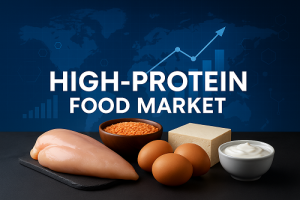The global high-protein food market has emerged as a cornerstone in functional nutrition. High-protein diets have transcended gym culture and now appeal to a much broader base, including health-conscious consumers, aging populations, and individuals managing lifestyle-related disorders such as obesity and diabetes. This blog delves into the market’s current dynamics, growth enablers, AI-driven innovations, segmentation analysis, and regional trends shaping the future of this thriving sector.

Market Overview
The global high-protein food market was valued at approximately USD 84.7 billion in 2024 and is projected to reach USD 148.3 billion by 2034, growing at a CAGR of 5.8% from 2025 to 2034. This robust growth reflects the increasing awareness of the importance of protein in daily diets and the rising popularity of convenient, protein-enriched food products.
Key segments driving the market include plant-based proteins, animal-derived proteins, dairy-based protein products, and protein supplements. Consumers are actively seeking clean-label, sustainable, and allergen-free protein alternatives especially in regions where lactose intolerance and veganism are on the rise.
Get a Sample Now: https://www.towardsfnb.com/download-sample/5477
Market Growth Factors
Several major factors are accelerating the expansion of the high-protein food market:
- Health & Wellness Revolution
Consumers globally are prioritizing balanced nutrition to combat fatigue, obesity, heart disease, and muscle loss. Protein-rich diets are perceived to support satiety, muscle development, and overall health.
- Fitness and Sports Nutrition Boom
The rapid increase in gym-goers, athletes, and fitness enthusiasts has fueled demand for ready-to-consume protein shakes, protein bars, and functional snacks.
- Rise in Aging Population
Elderly consumers are increasingly seeking protein-rich diets to maintain muscle mass and bone density, especially in countries like Japan, Germany, and the U.S.
- Shift Toward Plant-Based Diets
As sustainability and animal welfare become mainstream concerns, plant-based protein sources such as pea, soy, lentils, and chickpeas are gaining market traction.
- Urbanization & Busy Lifestyles
Convenience remains key. Protein-enriched ready-to-eat meals, beverages, and snacks are preferred by busy professionals and students.
Emerging Market Opportunities
The future of the high-protein food market is ripe with untapped potential:
- Innovative Protein Blends: Combining plant and animal proteins for enhanced nutrition and texture.
- Clean-Label & Organic Protein Sources: Consumers are gravitating toward non-GMO, organic, and additive-free options.
- Personalized Nutrition Solutions: AI-driven platforms are enabling custom protein diets based on individual health profiles.
- Protein Fortification in Everyday Foods: Opportunities to add protein in bakery, dairy, breakfast cereals, and beverages.
- Sustainable Protein Production: Investments in algae, insect-based proteins, and lab-grown meat alternatives are gaining ground.
Grab the Databook and Discover Key Industry Insights Instantly: https://www.towardsfnb.com/download-databook/5477
High Protein Food Market Top Companies
- Nestlé S.A. (Switzerland)
- Danone S.A. (France)
- Glanbia plc (Ireland)
- Archer Daniels Midland Company (ADM) (U.S.)
- PepsiCo, Inc. (through its brand Quaker Oats) (U.S.)
- Cargill, Incorporated (U.S.)
- Hormel Foods Corporation (U.S.)
- Tyson Foods, Inc. (U.S.)
- The Kraft Heinz Company (U.S.)
- Unilever PLC (U.K.)
- Kerry Group plc (Ireland)
- General Mills, Inc. (U.S.)
Get detailed pricing and reports now : https://www.towardsfnb.com/price/5495
The Impact of AI on the High-Protein Food Market
Artificial Intelligence is revolutionizing the high-protein food market in multiple ways:
- Personalized Diet Formulation
AI and machine learning algorithms help tailor protein intake based on biometrics, fitness goals, and health conditions, supporting the growth of customized products.
- Product Innovation & R&D
AI is expediting food product development, identifying the most effective protein combinations for taste, nutrition, and digestibility.
- Consumer Behavior Analytics
AI-driven tools analyze consumer purchase patterns and preferences, allowing brands to fine-tune product offerings and marketing strategies.
- Smart Manufacturing
AI-integrated smart factories are improving processing efficiency, quality control, and supply chain logistics in protein food production.
Segmentation Analysis
The high-protein food market can be segmented as follows:
By Source
- Animal-Based Proteins: Eggs, meat, poultry, dairy, seafood
- Plant-Based Proteins: Soy, pea, hemp, lentils, chickpeas
- Alternative Proteins: Algae, mycoprotein, insect protein
By Product Type
- Protein Supplements
- Protein-enriched Beverages
- Protein Bars & Snacks
- Ready-to-Eat Meals
- Breakfast Cereals
- Dairy Products (e.g., Greek yogurt, cottage cheese)
By Distribution Channel
- Supermarkets/Hypermarkets
- Online Retail
- Convenience Stores
- Specialty Nutrition Stores
- Pharmacies
By End User
- Sports & Fitness Enthusiasts
- General Consumers
- Elderly Population
- Clinical Patients
Region-Wise Insights
North America
- North America dominates the high-protein food market due to:
- High awareness about protein nutrition
- Large fitness-focused population
- Strong demand for plant-based and keto protein products
Europe
- Europe follows closely with demand driven by:
- Government support for plant-based innovation
- Clean-label product preferences
- Aging population in Germany, France, and the UK
Asia-Pacific
- Fastest-growing region with immense potential:
- Rapid urbanization and dietary westernization
- High lactose intolerance creating demand for plant proteins
- Expanding middle class in India and China
Latin America
- Rising adoption of high-protein diets:
- Growth in gym culture in Brazil and Mexico
- Increasing health awareness and urban middle class
Middle East & Africa
- Gradual market expansion:
- Health-focused dietary shift in the UAE and South Africa
- New opportunities through e-commerce and fortified foods
Outlook and Future Opportunities
The high-protein food market is not just a passing trend it’s a long-term lifestyle shift driven by health, sustainability, and convenience. As consumer demand continues to evolve, manufacturers that prioritize clean-label innovation, personalized nutrition, and sustainability while leveraging AI and technology are poised to lead this market into its next growth phase.
In a world where food is medicine and lifestyle is a choice, protein stands tall as the undisputed pillar of modern nutrition.